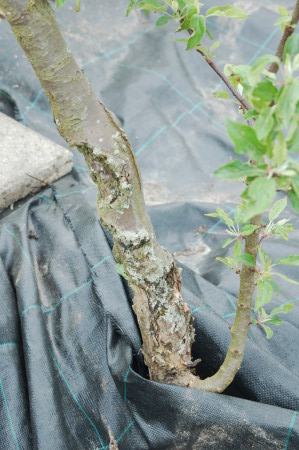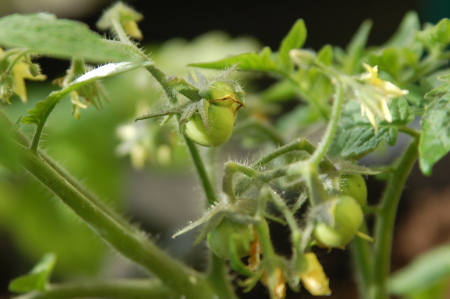This is a cross posting, also available at La Vida Locavore. For my regular readers, please bear with the somewhat introductory nature. Those of you who do regularly read this blog may want to check out some of the other posts on La Vida Locavore.
For me heirloom gardening is all about getting away from the mentality of growing things from a purchased packet of seeds. If you do grow plants from purchased seeds, you are always better off saving your own seeds if possible because with every generation they adapt to your garden, a process you can help along by being a little choosy with the plants you save seeds from.
Even better than starting with purchased seeds are those you can’t buy, and can only get for free or perhaps a small payment to cover shipping and handling costs. These might be plants growing wild somewhere, where someone has gone out and collected some seeds for you. Perhaps these are varieties someone has created in their own garden with amateur plant breeding techniques. You might spend the time to make contacts at academic institutions or seed banks, and find things in these collections or perhaps know someone who has already done this and can get some saved seeds from them. Even easier than saving seeds every year is to establish perennial plants in your garden, those that come back providing tasty things to eat each year.
If you’re interested in growing these sorts of plants, have a look at the blogger seed network with a number of people who will send plants and seeds most places in the world at little or no cost. The network currently has 24 people in 11 countries. Many people think these kinds of things cannot be sent into the US because of customs rules, but that isn’t always the case. Keep reading to see pictures and descriptions of a few of the plants I’m growing this year.
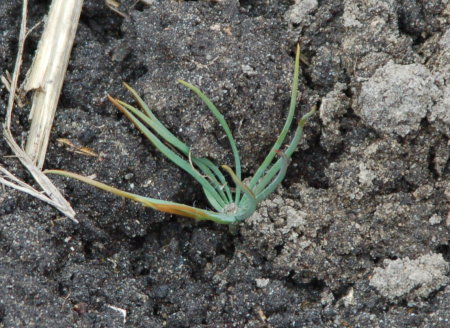
This is a Pinus Pinea tree, one of the most popular for growing pine nuts. Mary who lives in Greece sent me some seeds she collected from trees growing on her property. Any possible harvest from this is farther away than anything else I’m growing at the moment, and also one of my most uncertain. The climate in my garden is probably too wet for this tree that likes a dry climate, however they do grow in other parts of the Netherlands. I have read estimates ranging from 8-30 years for the first harvest. In addition, these trees are self fertile, which means I have to have two of them to cross pollinate each other! These will likely get quite large, so it’s not certain I will continue to have space for them. One of the things I hope to get from this tree is a shady place to sit, something I’m lacking in the garden at the moment and perhaps can expect to get sooner than a harvest of pine nuts. These trees are sometimes called umbrella pines, and grow up and out.
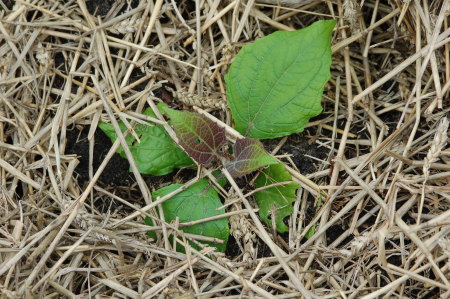
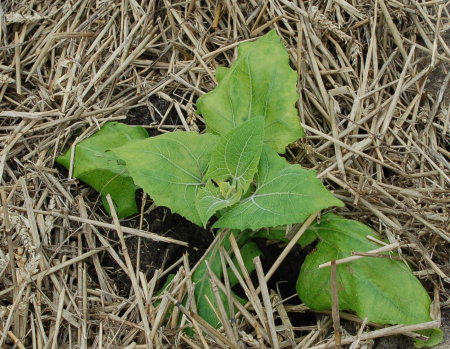
These are two different yacón plants, both from my Belgian friend Frank. This is a really interesting plant, one of the so called Lost Crops of the Incas. I did a post with pictures of the tubers here. This has the potential to become a very important crop in the future. It’s more productive than potatoes in the same space, with each plant yielding about 10Kg in less than a square meter. It’s well suited as a biofuel crop, because it has a high sugar content. It also has a nice taste, very sweet, almost like a melon. It’s not something to eat every day I think, but it’s nice to eat as a treat.
Especially if you live in the US, this is a good example of a plant not to purchase from a seed company. It’s very hard to find for sale in the US, and for example Seeds of Change was selling it this year for $20 per plant plus mandatory express shipping costs. On the other hand I sent a number of growing tubers to people in the US for free, as my cost was only that of a couple of postage stamps. A couple of people reported they received them successfully and are growing them now. I’ll almost certainly have more to send out in February, if you’re interested in giving it a try yourself.
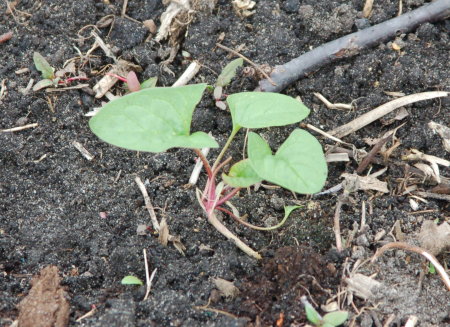
This plant is called Good King Henry (it goes by other names as well), and was sent to me by Søren in Denmark. It’s one of the limited number of edible plants that will tolerate some shade, and has leaves that can be eaten like spinach and shoots that can be eaten a bit like asparagus in the spring. This by the way is my third try with seeds from Søren. The first time, it got lost in the weeds. The second time I grew it too close to Jerusalem Artichokes, which grew over the top of them. If you ever get seeds or other plant materials from me, don’t be afraid to ask for more the following year if it doesn’t go well! Unexpected things can always happen.
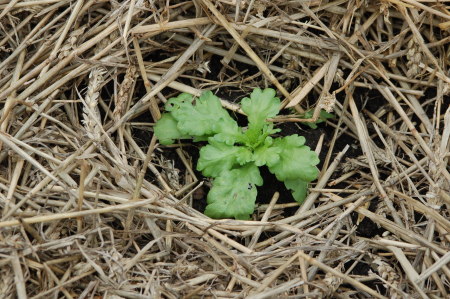
This is edible chrysanthium given to me by Kate of Australia, during her trip through Europe, Singapore and the US last year. I know you can eat the greens, and perhaps this is also the kind of plant you can harvest capers from? I’m not sure about that.
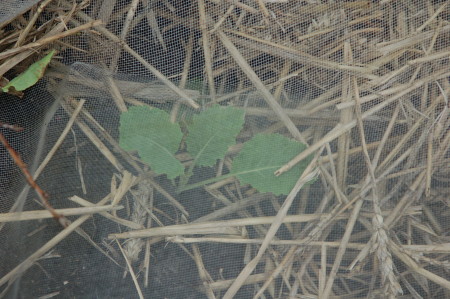
Cape Spitz cabbage. This was sent to me by Mike in South Africa, and is an oxheart shaped cabbage. This type of cabbage is very popular both in Holland as well as it’s former colonies, so I have a personal interest in seeing if there are major differences between what is grown locally and what is grown in SA. As well as the straw I use as mulch, this plant is also protected with a net.
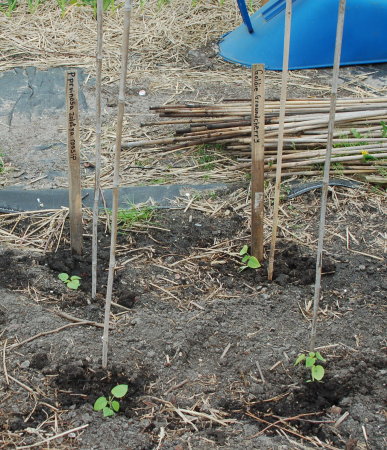
I’m growing a number of ground cherries this year. Inspired in part because my friend Frank in Belgium who I mentioned above collected a number of varieties and gave me some of the seeds, but also a number of other people have given me varieties as well. Laura in France and Ottawa Gardener in Canada have both given me varieties, as well as some I purchased from well known plant breeder Alan Kapuler’s seed company.
What are commonly referred to as ground cherries are actually a large number of different species of plants, with a reputation as being some of the best tasting solances (tomato, pepper, potato, eggplant and related plants).
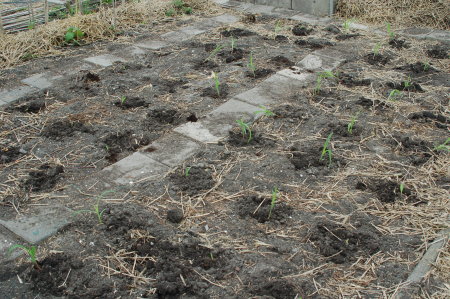
I’ve planted a variety of multi-colored sweet corn called Painted Hills, purchased from Alan Kapuler’s seed company. Seeds of change has a good picture of it in their catalog.
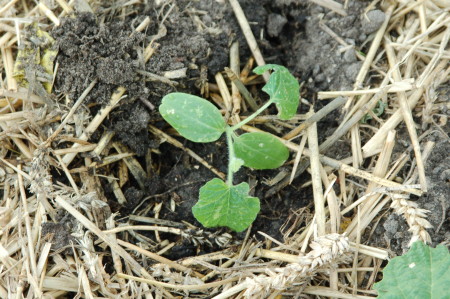
In my greenhouse I’m growing a fruit called Kiwano, from seeds sent to me by Riet who lives in Holland.
These are just a few plants I have growing now, and there’s lots to come! Please watch my blog to hear more, and if you’re interested in growing these kinds of plants, don’t be afraid to contact me or others in the Seed Network linked to at the beginning of this post.
Understand that I get a lot of emails, and this year with all the attention being paid to the president’s garden is going to be really busy for me. At the same time I love to hear from people of all skill levels with this kind of thing, and I always have 5 minutes to answer a question or point you to a source of a particular plant. If you see a plant on my blog, I probably have seeds I can send or can point you to another source. You can find contact information on the front page of my blog.
